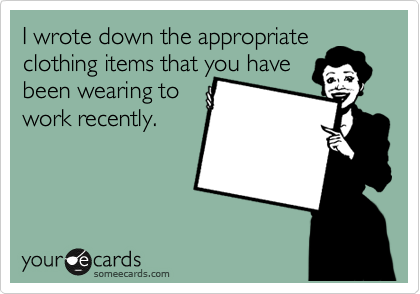
I am the last to point any fingers! I, too, get excited to reach deep in my closet and pull out the cute summer dresses, the tank tops and my colorful collection of flip flops when the weather is warming up. However, with every company I have worked at or with as a client, not a year goes by that I don’t have to remind employees what is and isn’t appropriate to wear to the office. In fact, I just spoke with a business owner this week about this very concern.
Years ago, one of my employees wore a summer top to the office that appeared respectable when standing. However, even the slightest lean forward would provide the entire office a display of her thong underwear that were riding higher than the jeans she was wearing. To make a point of it, and trying to be funny, one of the male employees reached over while she was bending to get some files out of a lower level drawer and snapped her thong.
She had it coming, didn’t she?
Well, she reported the incident. It resulted in an internal investigation, a written warning for the male employee and a refresher training on Sexual Harassment for the entire office.
What can you do to avoid those uncomfortable and time consuming situations at the workplace? Get proactive on having a dress code in place, especially for the summer season.
Here are some tips to consider when creating a dress code policy:
Determine Your ‘No-Go Zones’
- For ladies, this is typically making sure that bra straps, belly buttons, cleavage and lower back tattoos are not exposed. No shorts or beach flip-flops.
- For men, this is typically no bare shoulders, no shorts, no flip-flops, no ripped denim, and button down shirts with too many button undone.
Consider Clarifying Different Expectations by Department or Customer Contact.
- Salespersons or front desk receptionists might be required to ALWAYS keep their shoulders covered, since they are your first line of contact with your customers.
- Female desk employees might be entitled to wear sleeveless blouses as their interactions are limited to other co-workers.
- Warehouse staff might be able to wear shorts, but office employees cannot.
Write it Down and Make it Definitive.
- If you are going to make a policy that binds employees to a certain behavior, you should be very precise in your language to avoid any misinterpretation, e.g. all tattoos and piercings must be covered at all times.
- Even if you make an exception, say, for woman’s earrings, it’s best to be specific about how many earrings are appropriate.
Send out a “friendly reminder” of the dress code policy each year just PRIOR to the warm weather.
- Nine times out of ten, employees understand the purpose of a dress code and a friendly reminder is enough to remedy any usual violations.
- However, managers should be on guard if staff members react with any “red flag” objections that could be an early sign of trouble.
Keep in mind, the appearance of your staff should support your culture and create a credible image in the mind of your customer.
If you decide to tackle the development your own policy. I strongly recommend having it reviewed by an HR expert or an attorney. While Title VII of the Civil Rights Act prohibits any employer discrimination based on gender, race, or religion, these are obviously highly sensitive areas, so it’s best to ensure your policy has been reviewed appropriately to help avoid any legal issues down the road.
